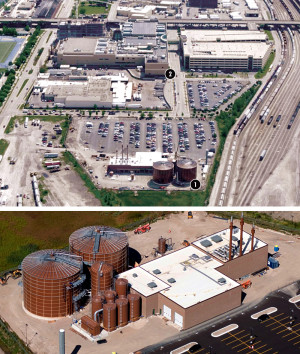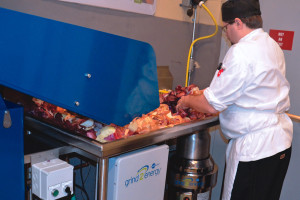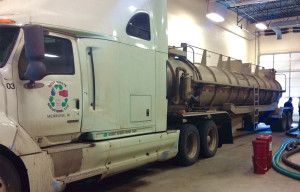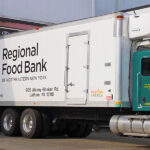Preconsumer food waste from the Potawatomi Bingo Casino in Milwaukee, along with feedstock from local generators, is processed in the Potawatomi Community’s new anaerobic digester.
Dan Emerson
BioCycle May 2014

The anaerobic digestion facility (#1 and bottom photo) has two 1.3 million gallon reactors, sized for 30-day hydraulic retention. It is located on a former brownfield on the western edge of the Potawatomi Bingo Casino’s property (see casino #2). Downtown Milwaukee is close by, just north of the property (not shown in photo). (Photos courtesy of Greenfire Management Services)
At the Potawatomi Bingo Casino in Milwaukee, Wisconsin, food waste that was previously landfilled has become a new source of heat and electricity for the casino properties. The casino is located across the parking lot from the Forest County Potawatomi Community’s new food waste biodigester facility, which started up last year and can generate up to 2 MW of electricity. About 3.5 tons/week of preconsumer food waste from the casino’s two largest kitchens — the production kitchen and the buffet kitchen — are being captured, according to executive chef Peter Gebauer. Annual generation is about 180 tons/year.
The Potawatomi casino recently installed a nonsewered food waste recycling system called Grind2Energy, made by InSinkErator, a business unit of Emerson. The system grinds the casino’s food waste and pumps it into an on-site, 2,000-gallon storage tank. The system is capturing about 90 percent of the preconsumer food waste, Gebauer estimates. “We have room to grow. Right now we’re evaluating our procedures and the equipment we’re using.”
Along with saving waste-handling tipping fees of $16 to $24/ton, the casino also will save by using about 700 fewer plastic garbage bags per month, he adds. Some paper goods are processed along with the food waste, “but not a lot.” The process of getting the Grind2Energy system up and running included some fine-tuning so the processed waste would flow easily through the biodigester plant’s pumping system, explains Charles Opferman, director of operations for Milwaukee-based Greenfire Management Services, which handles construction, property and development management for the Forest County Potawatomi Community (FCPC), a tribal reservation. That included adding more water to the tank to compensate for a higher than expected amount of solids. A valve which pumps water to the tank was changed from 2 to 4 gallons/minute, and an air admittance valve was added to aid in draining the tank.
“Due to overall increases in material being captured, we are also looking at increasing the size of the storage tank,” adds Opferman. Another potential change could be adding an agitator unit to prevent the solid and liquid waste from separating in the tank. “That will keep everything suspended,” he adds.
Getting kitchen employees involved in the food waste diversion has been relatively easy, notes Gebauer. “Because the separation procedure is pretty simple, it only took 45 minutes to an hour to train the employees. It’s important to get buy-in, and everybody seems to be embracing it.”

The casino recently installed a Grind2Energy unit that grinds the food waste and pumps the slurry into an on-site 2,000-gallon storage tank.
The grinder is located next to the casino’s loading dock. The device’s storage tank is equipped with an electronic sensor to detect when it’s full enough for service, and sends a signal that it’s time for a pick up (once a week at this time). The slurried food is vacuumed out of the tank and transferred to the digester by tank truck. “We’re evaluating how we can improve on our use of the equipment and procedures, to drive more volume,” Gebauer says. One slight complication is that seafood shells cannot be put in the grinder. “We’re looking for avenues to compost them.”
Overall, he adds, food waste diversion has “been a pretty exciting undertaking for us. We’ve had challenges, which is understandable when you do a pilot project. We would have liked the new technology installed sooner. But, within the first six weeks (of operation), we had already reached a level we had thought we wouldn’t reach until three to six months out.”
Going forward, Gebauer notes that the major challenges are “tweaking” the procedures in place, and sanitation. “With containers going back and forth between the kitchen and the processing area, it is imperative that the containers are washed before being placed in the kitchen again. We want to make sure there is no cross-contamination.” These procedures are also critical as there are plans to expand the program to include the casino’s smaller kitchens.

Slurry from the casino kitchen, as well as substrates from area food processors and grocery stores, are unloaded within enclosed material bays to eliminate any fugitive air emissions. (Photo courtesy of Greenfire Management Services)
Digester Operations
The FCPC’s anaerobic digester has two 1.3 million gallon reactors, sized for 30-day hydraulic retention. The reactors can operate in both CSTR (continuous stirred tank reactor) and membrane mode, according to Opferman. Feedstocks are directed to separate digesters, based on insoluble fiber content. The digester is used in membrane mode with feedstocks with lower fiber content. The facility began operating in October 2013, and utilizes technology designed by New Jersey-based Biothane (a division of Veolia Water Technologies).
“We’re still in start-up mode with the biodigester, and are still looking for more feedstock,” says Opferman. “Along with preconsumer food waste and yellow grease from the casino, feedstocks include the by-products of meat, condiment, beverage, dairy and cheese production from nearby food processors. The facility also receives produce waste from area grocery stores.” Hydraulic capacity of the digesters is 132,000 gallons/day (92,500 lbs of COD). The frequency and volume of deliveries are dependent on production cycles of the various sources. Deliveries range from multiple loads daily to biweekly for different generators.
All incoming feedstocks are unloaded within enclosed material bays to eliminate any fugitive air emissions from the feedstocks and by-products. “We want to be good neighbors,” Opferman notes. Material is screened and further emulsified by the chopper pumps within the plant.
The AD facility is located in Milwaukee’s Menomonee River Valley, near the downtown. The site is on the far western edge of the Potawatomi Bingo Casino’s property, between a retention basin, an employee parking lot and two railroad yards. The entire site was built on reclaimed land (a former brownfield) that the Menomonee Valley Plan had deemed undevelopable. The Forest County Executive Council and Potawatomi community chose that site after analyzing “various energy-use and feedstock supply options” in areas of both Milwaukee and Forest County, Opferman explains.
The $20 million project was financed by the Potawatomi tribe. Initial funding came from a Community Renewable Energy Deployment grant received from the U.S. Department of Energy and implementation grants from Focus on Energy, Wisconsin utilities’ statewide energy efficiency and renewable resource program. Additional funding is being secured through a U.S. Treasury Section 1603 Grant (in lieu of tax credit) that expired at the end of 2011. To qualify for the 1603 funds, the digester had to be generating electricity by the end of 2013, which was accomplished.
In its first six months of operation, the facility has been ramping up biogas production. The project is designed for 520 SCFM of gas production. “Gas production has been exceeding organic loading rates through start-up because of the particular feedstocks we are getting,” Opferman explains. “The plant hasn’t reached full production yet because of the overall feedstock supply. Local haulers were initially reluctant to commit to utilizing the facility until they became convinced it was not going to violate confidentiality of their business arrangements.”
Two GE-Waukesha APG 1000 (1,000 kW) engines are used to combust the biogas. Heat recovered from the engines and from downdraft stack economizers is used to keep the biodigester tanks at the desired 98°F. Excess heat is also used to serve the new hotel and casino’s domestic hot water needs. FCPC Renewable Generation, LLC (the ownership entity) has a 15-year contract to sell the power produced to the local electrical utility, We Energies, which serves parts of Wisconsin and Michigan’s Upper Peninsula.
Effluent from the digester goes to the Milwaukee Metropolitan Sewerage District’s (MMSD) wastewater treatment plant, which dries sewage sludge and processes it into a fertilizer, Milorganite. “The nitrogen level of Milorganite is low by commercial standards,” explains Opferman. “We don’t remove the nitrogen from our effluent; MMSD is happy to get all the nitrogen and phosphorous we can send them for their fertilizer.”
Dan Emerson is a Contributing Editor to BioCycle.












